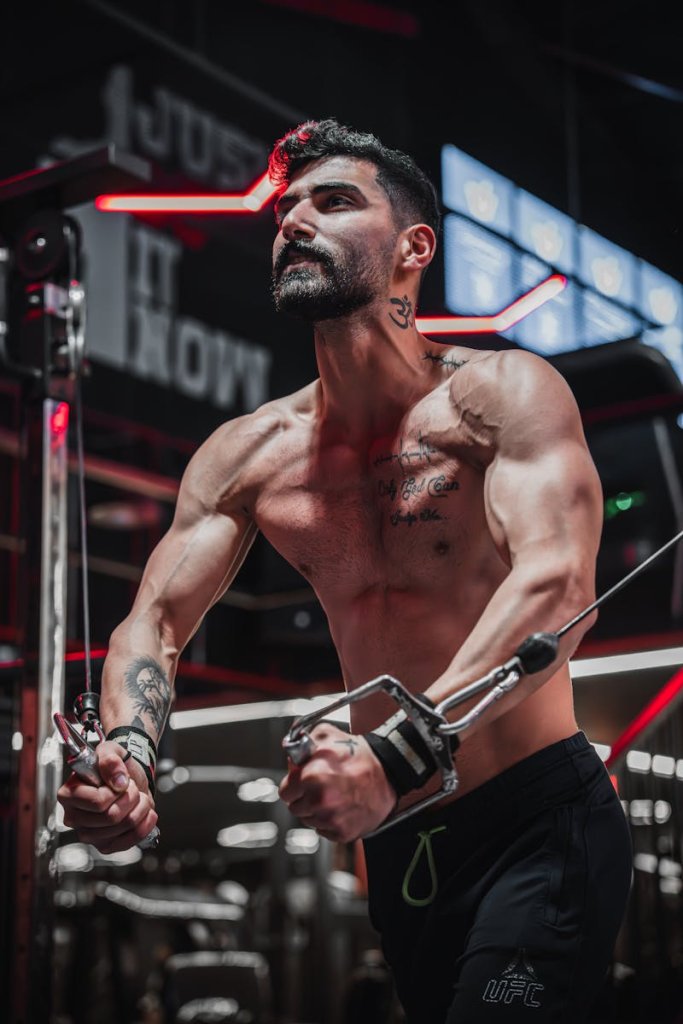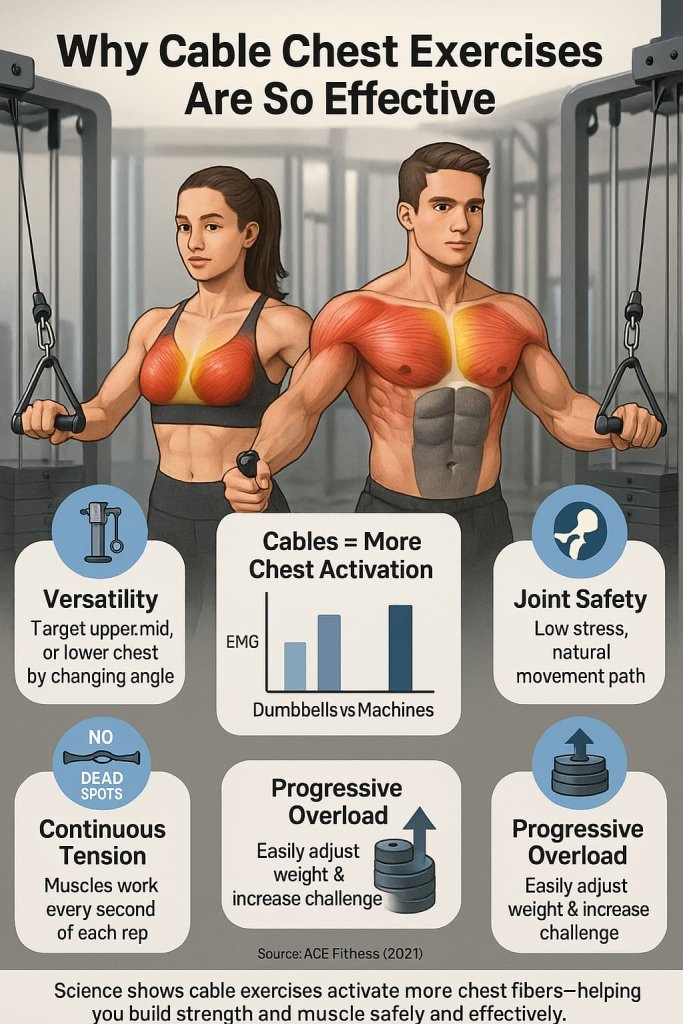The best cable chest exercises deliver more muscle growth, constant tension, and joint safety compared to most free-weight moves—proven by EMG research and top trainers. If your goal is a bigger, stronger, and better-shaped chest, cable exercises are your smartest bet. Mastering the right cable moves ensures you target every angle of your chest, fix muscle imbalances, and protect your shoulders.

Why is this so important? Many lifters plateau with just barbells or machines. Cables let you work the chest from all angles, with more freedom of movement and safer mechanics. Below, you’ll find science-backed explanations, expert trainer tips, up-to-date research, and a complete list of the 17 best cable chest exercises.
Why Cable Chest Exercises Are So Effective
Science-Backed Muscle Activation
Cables stand out because they keep tension on the muscle from start to finish, maximizing time under tension—crucial for muscle growth. According to an ACE Fitness EMG study (2021), cable flys and crossovers often activate more chest fibers than dumbbell or machine exercises, especially in the mid and lower pecs.

Key Benefits
- Versatility: Adjust cable height or bench position to hit upper, middle, or lower chest.
- Joint Safety: The cable’s freedom of movement means less shoulder stress and a lower risk of injury.
- Continuous Tension: No “dead spots” or resting points; your pecs are working every second.
- Progressive Overload: Easy to add weight, change angles, or use one arm at a time for extra challenge.
Real-World Example
Physical therapists and top strength coaches use cable exercises for athletes rehabbing shoulder injuries, since the natural motion path of cables protects the joints while still building strength.
Pro Tip: Always control the weight on the way back (“eccentric” phase) for extra muscle growth.
The 17 Best Cable Chest Exercises (With Detailed Descriptions)
1. Standing Cable Chest Fly
How to do it:
Stand centered between two cable stacks, each handle set at shoulder height. Take a slight step forward (one foot staggered), grasp handles with palms facing forward, arms almost straight (slight elbow bend). Bring handles together in a hugging motion in front of your chest. Focus on bringing your pinkies together for extra inner chest squeeze.
Why it works:
Standing flies offer continuous tension through the full range of motion—unlike dumbbells, the cables challenge your chest even at the peak contraction and full stretch. Perfect for mid-chest thickness and overall shape.
Trainer tip:
Keep your chest high, shoulders back and down, and avoid hyperextending your elbows behind your body. Move slowly and with control for maximal muscle engagement.
Pro insight:
Adjust the handle height slightly to bias different pec fibers.
2. Low-to-High Cable Fly
Setup:
Position both pulleys at their lowest point. Stand tall, grab handles, and bring your hands up in a wide arc from hip height to about chin or eye level.
What it targets:
Strongly emphasizes the upper (clavicular) pecs and front deltoids, helping you sculpt that sought-after “square” upper chest.
Practical tip:
Squeeze and pause at the top for 1–2 seconds to maximize upper chest fiber activation.
3. High-to-Low Cable Fly
Setup:
Set cables at the highest position. With a soft bend in the elbows, draw handles downward and inward toward your hips in a wide arc.
Benefit:
This exercise shifts the focus to your lower (sternal) pec fibers, helping you develop the lower chest and that “chest shelf” look.
Tip:
Don’t let hands touch at the bottom—stop just short and squeeze.
4. Single-Arm Cable Fly
Why:
Using one arm at a time helps correct muscle imbalances and allows for greater concentration on the working side, enhancing the mind-muscle connection.
How:
Perform the standard cable fly with one arm while your free hand rests on your core or hip for stability. Slight torso rotation toward the working arm can increase the stretch and contraction.
Trainer tip:
Keep your core braced to prevent twisting or shifting during the movement.
5. Cable Crossover
Technique:
Stand in the center of the cable machine, arms wide and hands holding high handles. Lean forward slightly at the waist. Pull handles down and across your body so wrists cross slightly at the end.
Science:
Studies show the cable crossover provides a deep stretch and maximum contraction, with high chest muscle fiber recruitment.
Real-world example:
Bodybuilders use this as a finishing move for chest day to fully exhaust the pecs.
6. Standing Cable Chest Press
How:
Handles at chest height. Stand in a split stance (one foot forward), grip handles, and press them straight ahead, fully extending your arms.
Benefit:
Engages chest, shoulders, and triceps. Standing position also activates your core to stabilize, mimicking a functional pushing movement used in many sports.
Tip:
Focus on pushing through the heel of your hand for optimal chest activation.
7. Incline Cable Chest Press
Bench angle:
Set a bench to a 30–45° incline. Position cables low and sit back, pressing handles upward and together in line with your upper chest.
Target:
Mainly works the upper chest and front delts. The cable path allows for a more natural range of motion than barbells or machines.
Trainer insight:
EMG studies confirm this move achieves higher upper pec activation than the standard incline bench press.
8. Decline Cable Chest Press
Bench:
Slight decline (10–20°). Set cables to a high position, lie back, and press handles down and out.
Why it’s great:
Places emphasis on the lower chest, reduces shoulder strain, and encourages strong peak contraction at the bottom.
Tip:
Keep wrists neutral and drive through your elbows, not your hands.
9. Seated Cable Chest Press
How to:
Sit upright on a bench (or seat), handles at chest level. Plant feet, brace core, and press forward.
Best for:
Those who want to isolate the chest with less core stabilization. Also ideal for beginners learning the pressing path.
Modification:
Use a back support for even more isolation.
10. Lying Cable Chest Fly
Setup:
Place a flat bench between low cable pulleys. Lie down, grab handles, and fly arms up and together in a hugging motion.
Why:
Delivers a huge stretch with continuous tension throughout, minimizing joint strain.
Tip:
Control the descent, and stop when elbows reach bench height to protect shoulders.
11. Incline Cable Fly
Bench:
30–45° incline. Cables set low. Lie back and fly arms up and together above your upper chest.
What it hits:
Upper-inner chest—great for building a fuller, “lifted” look.
Tip:
Squeeze and hold the top contraction for maximum effect.
12. Decline Cable Fly
Bench:
Set at a slight decline. Cables high. Lie back and pull handles downward and together.
Focus:
Targets lower pecs and outer chest, creating the appearance of a more defined, rounded chest.
13. Cable Squeeze Press
How to:
Stand or lie on a bench, press cable handles together as hard as possible while extending arms, keeping elbows close to your sides.
Advantage:
Supercharges inner chest fiber activation—great for improving the “cleavage line” or sternum separation.
Pro tip:
Use moderate weight and high reps for a brutal finisher.
14. Cable Press-Around
Motion:
Press handles forward, then wrap arms inward as if giving a big bear hug.
Best for:
Maximizes contraction of the chest in the shortened range, often missed in traditional presses.
Variation:
Pause and squeeze at the peak for added intensity.
15. Cable Pullover
Hybrid move:
Works chest and lats. Lie on a bench, cables behind your head. Keep arms nearly straight and pull handles over your chest.
Tip:
Maintain a soft elbow bend. Don’t let your hips lift off the bench.
Why:
A fantastic “finisher” that stretches and pumps both pecs and lats.
16. Close-Grip Cable Press
How to:
Press cable handles together, elbows tight to the sides. Focus on squeezing handles inward during the press.
Good for:
Isolating the inner chest for better separation and center line.
Trainer advice:
Great as a pre-exhaust or finisher move.
17. Cable Iron Cross
Setup:
Cables high. Stand in the center, arms wide, palms down. Pull handles down and outward to your hips, arms mostly straight.
Why:
Emphasizes lower and outer chest, building width and that “armor plate” look.
Tip:
Keep shoulders down and core tight to avoid using traps or swinging.
Research & Data: What the Science Says
- EMG research from ACE Fitness (2021): Cable flys and crossovers showed higher mid- and lower-chest activation than most dumbbell or machine moves. Standing cable presses recruit more stabilizers, aiding functional strength.
- Expert trainers like Jeff Cavaliere (Athlean-X): Recommend cable exercises for continuous tension and safer mechanics, especially for lifters with prior shoulder issues.
- Recent updates (2025): New cable machines now feature easier angle adjustments, dual pulley systems, and built-in digital rep counters—making progression even simpler.
Sources:
ACE Fitness – EMG Analysis of Chest Exercises (2021)
Athlean-X – Cable Chest Workout (2025)
How to Build a Complete Cable Chest Workout
Sample Workout (Hypertrophy Focus)
- Standing Cable Chest Fly – 3 sets of 12–15 reps
- Incline Cable Chest Press – 3 sets of 8–12 reps
- High-to-Low Cable Fly – 3 sets of 12–15 reps
- Cable Crossover – 3 sets of 15–20 reps
- Single-Arm Cable Fly – 2 sets of 10–12 reps per side
Tips for Best Results
- Control Every Rep: Don’t let cables pull you back fast. Slow negatives build muscle.
- Angle Matters: Change cable heights to emphasize upper, mid, or lower chest.
- Start Light: Perfect your form before increasing weight.
- Mind-Muscle Connection: Focus on your chest working, not your arms or shoulders.
Advanced Progressions
- Use tempo reps (3 seconds up, 3 seconds down) for deeper burn.
- Add drop sets or rest-pause sets for intensity.
Real-World Example
Professional physique competitors rotate cable angles weekly to ensure every chest fiber is targeted, preventing stagnation and boosting definition.
Frequently Asked Questions (FAQs)
- Are cable chest exercises suitable for beginners?
Absolutely. Most moves are easy to learn and adjustable for all strength levels. Start with lighter weights and focus on slow, controlled movement. - Can I build a big chest using only cables?
Yes! Cables activate all chest regions effectively, as proven by research and trainers. Combine multiple angles for best growth. - How do I avoid shoulder pain with cable chest exercises?
Always warm up, set cables at or slightly below shoulder height, and keep a slight bend in your elbows. Avoid overstretching at the bottom of flys. - How many times per week should I do cable chest workouts?
For most, 1–2 focused sessions per week are ideal. Allow at least 48 hours between sessions for recovery. - Should I use one arm at a time or both?
Mix both. Unilateral (one-arm) exercises help fix imbalances; bilateral (both arms) let you lift heavier. - What’s better—high reps or low reps?
For size, stick to 8–15 reps per set. For definition or endurance, use 15–20 reps. Always prioritize form.
Additional Real-World Tips
- Superset for Pump: Pair cable flys with push-ups or dips for maximum chest fatigue and growth.
- Adjust Cables Often: Slight changes in angle can “wake up” lagging muscle fibers.
- Track Progress: Use gym log apps or the cable machine’s digital counter for consistent overload.
Conclusion
Cable chest exercises are a science-backed, trainer-approved path to bigger, stronger, and safer pecs. They keep tension on your muscles, protect your joints, and allow endless variety to keep your workouts fresh. Use these 17 moves and the workout guide above to take your results to the next level—whether you’re training for size, symmetry, or function.
